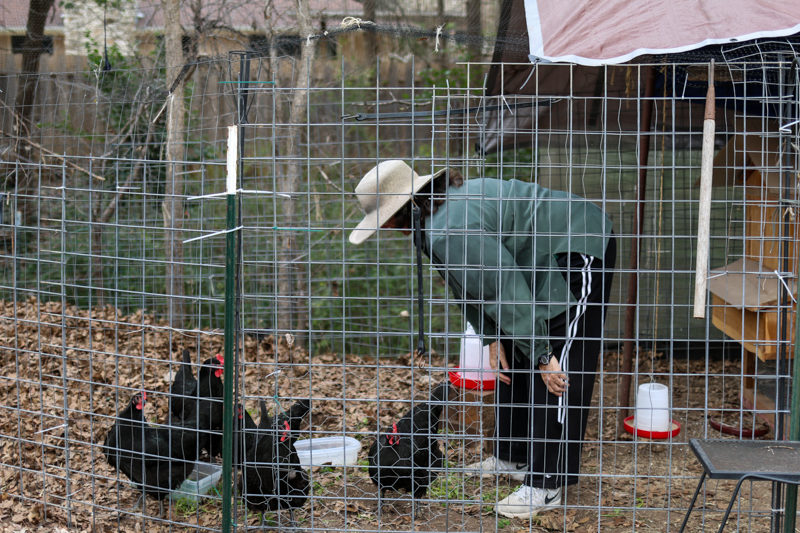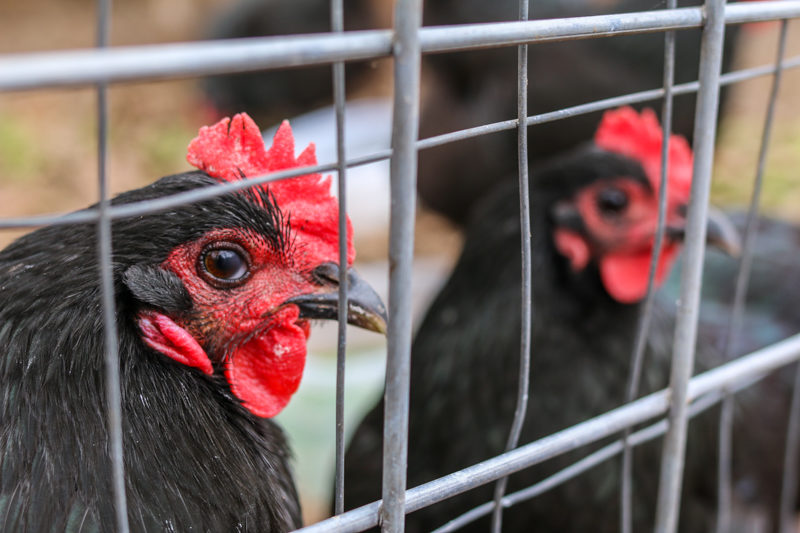Few Austinites Are Flocking to the City’s $75 Chicken Coop Rebate
By Carlos Anchondo
Photography By Hailey Hess
Reporting Texas

Jean El Harim received a $75 rebate from the city to offset the cost of a backyard chicken coop. She has five hens in her Southwest Austin yard. Hailey Hess/Reporting Texas
Jean El Harim has prepared a feast to reward her hens. Crouching low among “the ladies,” El Harim places an assortment of wheatberries, chickweed and henbit at their feet. The five hens descend on the food in a flash of iridescent black feathers.
“Aren’t they beautiful?” asks El Harim, gesturing to five tawny brown eggs, each nestled in a small wicker basket. The hens are Australorps, a breed known as dependable egg-layers.
El Harim got her flock last May, a few weeks after the City of Austin launched a rebate program to encourage residents to own backyard chickens. Nearly a year after the program started, she is among just 14 people who have received the rebate, up to $75, and are now keeping hens in city-subsidized coops.
By comparison, in fiscal year 2017, 628 people received city rebates for purchasing home composting bins, and 5,217 rebates have been issued since that program started. Both initiatives are designed to reduce waste going to landfills. The city says an average chicken eats about seven pounds of food scraps a month.

El Harim shows off the brown eggs her hens laid one morning. Hailey Hess/Reporting Texas
More than 300 people have attended city-sponsored, hour-long chicken-keeping classes — a requirement of the program — organized by Austin Resource Recovery.
Susanne Harm, a spokesperson for Austin Resource Recovery, said the department expects participation in the chicken coop rebate program to increase come spring.
“With the rebate program as a whole, both the compost and chicken coop rebate, we are looking to penetrate about 10 percent of households in Austin,” Harm says.
That would mean about 20,000 households would have participated in one or both rebate programs by 2011, the city’s target date, she said.
Austin appears to be unique in offering a chicken coop rebate; no other city showed up in a Google search.
Michelle Hernandez, a dedicated chicken keeper and organizer of the annual Funky Chicken Coop Tour and of a local backyard poultry meetup, was a major proponent of the rebate. The Resource Recovery Department and the city’s Office of Sustainability approved it.
Hernandez is one of two contractors who teach the chicken-keeping classes, which are held at libraries, bookstores and farmer’s markets.
“Chickens are built to be zero-waste heroes, transforming household waste into valuable compost for lawn and garden,” says Hernandez, who has raised chickens for the past 10 years.
A recent class at Recycled Reads, the Austin Public Library’s used book store on Burnet Road, drew more than 20 would-be chicken owners. The class covered topics such as city ordinances, protecting hens from predators and how to choose the right breed. She thanked the class for being “part of the change” before promoting the benefits of the rebate.

El Harim and her husband built an enclosure to keep the birds safe from predators. Hailey Hess/Reporting Texas
In her Southwest Austin backyard, El Harim sees the benefits daily. Her hens eat insects, which help her avoid using pesticides. She uses the hen’s poop, called “black gold” in the chicken community, as fertilizer. She’s trained her hens where to lay by using plastic eggs filled with sand, to lure them to places where the eggs would not be hard to find or broken.
If El Harim’s run is a fortress — with heavy-duty wire fencing and a tarp covering to deter predators — then her coop is its castle. She bought the coop, made from fallen cedar, at the Hillbilly Sawmill in Bastrop, where cedar coops range from $250 to $750, depending on their size.
El Harim says the coop is the most expensive part of keeping chickens and she is glad that the city has invested in a more sustainable future. But for her, the enjoyment of owning chickens is just as important.
“I’ve had these ladies since they were one day old,” says El Harim, cradling one hen in her arms as you would a small dog. “I am able to watch them from my house and I can see how happy they are here, safe and healthy in their run.”

El Harim’s hens are all black Australorps, an Australian breed known for its shiny black feathers with hints of green and purple. Hailey Hess/Reporting Texas